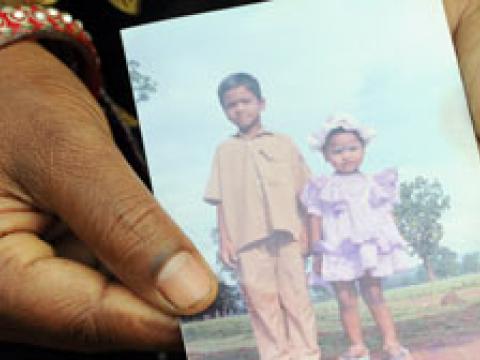Malaria killed their daughter: Indian parents demand better health facilities

By: Theodore Sam, Communications; World Vision India
Nirmala holds in her hands the only photo of her daughter and recalls with grief how malaria killed her child, simply because there was no proper hospital near her village.
It was a Friday morning. Nirmala’s three-year-old daughter Mohini was down with a high temperature. Nirmala took her to the Primary Health Center (PHC) near her village. The PHC had only one doctor and very limited facilities; they could not take or test a blood sample. The doctor diagnosed Mohini’s condition as a simple fever and recommended that she take some drugs.
On Saturday, the temperature failed to drop despite the medication. She went back to the PHC where the same doctor advised her to continue to take the drugs he had prescribed the day before.
On Sunday, young Mohini’s body was still burning with a high fever. With no other choice, Nirmala took her daughter to the District Headquarters Hospital 15km from the village. The hospital admitted Mohini at 10am in a serious condition. By 3pm Mohini died of malaria.
Nirmala and her community are part of the Santal tribe, which is the largest tribal community in India. Their village, Sapanchua, is situated within the Mayurbhanj District in the north Indian state of Orissa and has little access to regular health care.
“Even that one doctor was irregular and whenever a pregnancy got even slightly complicated, he would ask us to go to the District Headquarters Hospital,” says Nirmala.
For anything beyond a common flu, the villagers had to travel to the District Headquarters which was 15km from the village. No proper roads and transport facilities made it even more difficult to access the hospital. Many children lost their lives due to easily preventable and curable diseases like malaria.
For Nirmala, the death of her child got her thinking. “My husband and I took an oath that we will not let any other child in this village die of malaria again.”
“My husband and I took an oath that we will not let any other child in this village die of malaria again.”
During this time, World Vision conducted many health awareness programmes and taught the community about various programs the government of India had for education, employment and health and their entitlements under each scheme. World Vision explained how to formally file complaints, how and whom to approach to demand services that should have rightfully been given to them.
“It was only then we realised how much we were suffering,” Nirmala says.
Just a few months before her daughter’s death, Nirmala became a local Anganwadi (child services) worker. This gave her a chance to officially interact with government officials and the doctor and pharmacist at the PHC. Equipped with information that she learnt from World Vision’s awareness programmes, Nirmala consistently raised the issue of the poor health care facilities in her village at every meeting with her seniors.
Nirmala and a few other elders from the community also filed a formal request demanding better health care facilities and entitlements. They approached senior government officials and local political parties both in writing and in person about the issue. For four years the entire community worked with a single minded goal – to get a better health care centre for the village.
In 2010, their advocacy efforts bore fruit. The government made the Primary Health Center (PHC) into a Community Health Center (CHC). This meant more doctors including specialists, a pathology service with a lab technician and enough facilities, equipment and expertise to handle many complications that were previously beyond the capacity of health workers here.
Nowadays, unless it’s a very serious case of illness, the villagers do not have to go to the District Headquarters Hospital anymore. The community is now extremely happy that they do not have to leave work, pay a large sum for transport and lose time travelling 15km for emergency treatment. The CHC has three doctors and the community hopes for two more. Additionally, the community hopes to have a paediatrician join the health team. The community is continuing with their advocacy efforts to make sure that the CHC gets enough doctors and equipment.